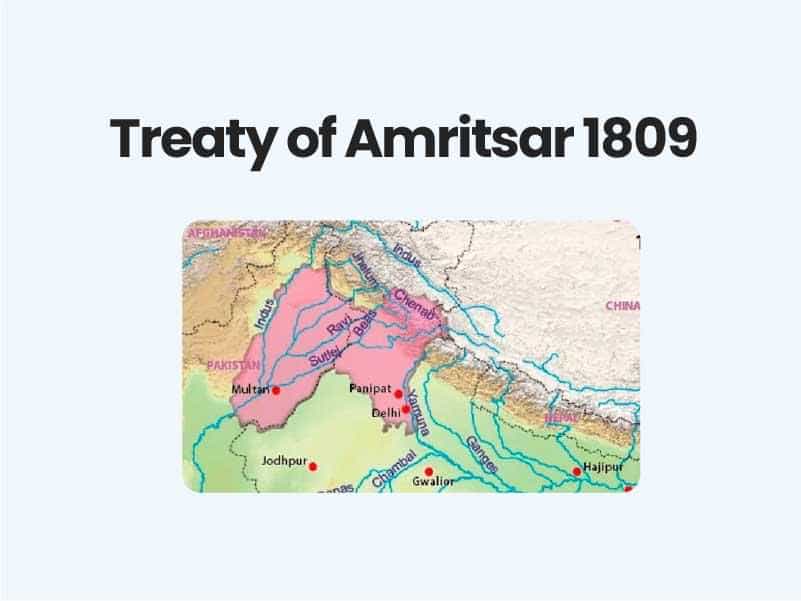Companion@360 → 7 Month programme to sharpen your writing skills → REGISTER NOW

Treaty of Amritsar 1809
The Treaty of Amritsar of 1809 was an agreement between the British East India Company and Ranjit Singh, the Sikh leader who founded the Sikh empire.
Significance of Treaty of Amritsar:
- Kashmiris protesting the security lockdown and snapping of communications links in the state have on multiple occasions referred to 1846, the year in which, as a National Conference leader put it, “Kashmiris were sold, along with their land, water and sky over their heads”.
- It was in that year that the back-to-back Treaties of Lahore and Amritsar were signed. These treaties may be considered the starting point of the modern history of Kashmir under the Hindu Dogra rulers of Jammu.
- The princely state of Jammu and Kashmir came into existence on March 16, 1846, the day the Treaty of Amritsar was signed between the British East India Company and the Dogra ruler Maharaja Gulab Singh.
- The Treaty of Amritsar was a formalisation of the proposals of the Treaty of Lahore, signed to conclude the First Anglo-Sikh War of 1845-46 between the East India Company and the Sikh Empire.
Provision of treaty:
- For strategic and diplomatic reasons, Lord Minto concluded a treaty with Ranjit Singh at Amritsar in 1809 through Metcalf in order to check the Sikh advance beyond Sutlej.
- By this treaty, the Sutlej was fixed as the boundry between the British East India Company and Maharaja Ranjit Singh.
Read Also Triratna of Jainism
Formation of the state of Jammu and Kashmir:
- The forces of Maharaja Ranjit Singh ran over the Kashmir Valley in 1819. The following year, Ranjit Singh made his Dogra general, Gulab Singh, the Raja of the State of Jammu.
- Gulab Singh ventured out to expand the boundaries of his empire, conquering Ladakh in the 1830s and Baltistan (in Pakistan) in the 1840s. Gulab Singh also advanced towards Tibet in 1841, but could not progress.
- At the same time that Gulab Singh was made the Raja of the State of Jammu, Maharaja Ranjit Singh gave to Dhyan Singh (Gulab Singh’s brother), as a jagir, the district of Poonch (located in the Jammu and Kashmir).
- Therefore, Poonch too became a separate state, different from Gulab Singh’s Jammu. However, Dhyan Singh faced a series of rebellions from his majority Muslim subjects.
- The Valley remained with the Sikhs until a little after Maharaja Ranjit Singh’s death in 1839. After the defeat in the Anglo-Sikh War, the Sikh Empire had to cede Kashmir to the English East India Company through the Treaty of Lahore, which was signed on March 9, 1846.
- Due to Gulab Singh’s neutrality during the Anglo-Sikh War, the British granted him dominion over Jammu and Kashmir through a sale deed, which was formalised through the Treaty of Amritsar.
- This treaty was signed a week after the Treaty of Lahore, on March 16, 1846. Gulab Singh ‘bought’ the state from the East India Company for a sum of Rs 75 lakh. The state of Jammu and Kashmir was thus formed, a Muslim-majority state with a Hindu Dogra ruler.
- The last ruling Maharaja of the Dogra dynasty was Maharaja Hari Singh, the son of Raja Amar Singh Jamwal and the nephew of his predecessor in the Dogra dynasty, Maharaja Pratap Singh. Hari Singh acceded to India in 1947.
Treaty of Amritsar, (April 25, 1809), pact concluded between Charles T. Metcalfe, representing the British East India Company, and Ranjit Singh, head of the Sikh kingdom of Punjab.
The treaty settled Indo-Sikh relations for a generation. The immediate occasion was the French threat to northwestern India, following Napoleon’s Treaty of Tilsit with Russia (1807) and Ranjit’s attempt to bring the Cis-Sutlej states under his control.
The British wanted a defensive treaty against the French and control of Punjab to the Sutlej River. Although this was not a defensive treaty, it did fix the frontier of lands controlled by Ranjit broadly along the line of the Sutlej River.
Metcalfe’s mission gave Ranjit much respect for the company’s disciplined troops as well as the determination never to cross swords with the British troops. Ranjit’s further conquests were to the west and north.
Practice UPSC Prelims Mock Test


